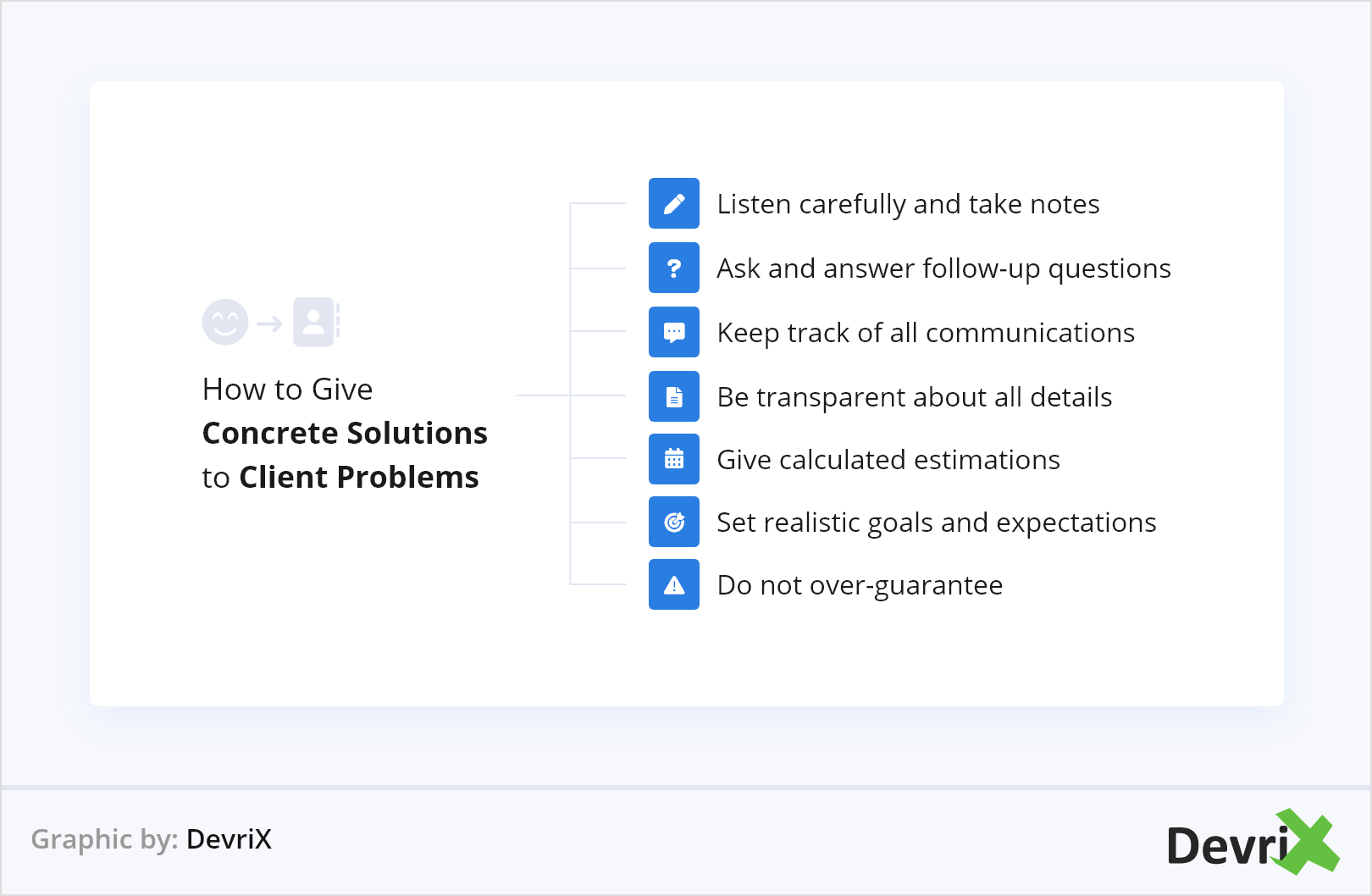Mastering client communication is a process that requires practice. To attract and retain the right clients, you need to be an exceptional communicator. This is a key requirement for creating a mutually beneficial partnership, where both you and your client’s business can thrive.
Winning at client communication, also means mastering the art of negotiation. Great communicators think critically, are emotionally neutral, present, observant, flexible, and respectful. If you learn to do all of these well, you’ll be able to successfully and effectively clarify your clients’ expectations, close more sales, increase loyalty, and improve your customer lifetime value.
Excellent communication can help solve many business problems. The most appropriate communication strategy depends on your company’s unique business and their clients. And while it’s very important that you tailor your messaging to the specific client, establishing some key practices is essential.
Hence, in this article we have put together a guide to winning at client communication. We have outlined the most important dos and don’ts, so you can ensure mutual win-win results.
Have a Professional, Yet Friendly Approach
Efficient client communication is a fundamental part of fostering strong and lasting relationships. Your efforts should be professional, with a friendly approach, and provide consistent, personalized, meaningful exchange of information. The ultimate goal of such exchanges should be to have mutually advantageous discussions, that lead to win-win situations for both parties.
To ensure that any conversation you and your client have has a positive outcome, remember to be on time, to be prepared and to be present. Simply showing up physically or virtually, doesn’t equate to providing your undivided attention. It’s important to pay attention to the details, and ask follow-up questions, not to have your client repeat what they said.
Try to anticipate questions and be ready to ask some on the go. This is very important at any stage of your client communications. Whether you’re just starting to talk or you’re discussing details about a project you’re working on, asking questions can bring plenty of benefits. Communication is essentially an exchange of information, so the more you ask, the more you’ll know.
Get Lessons from Feedback
Learn to extract constructive feedback from discussions with your clients. In some cases, your point of view might be different from your client’s. When this happens, take active efforts to understand where they’re coming from. Do not let frustration get in the way, and don’t be afraid to ask for more information or a better clarification if and when needed.
Additionally, get to know your client’s needs and requests, and be warm and welcoming. You’re in business with humans, not robots, and building a deeper connection with your clients will help you provide them with much better service.
Contrary to the belief that business communications should be cold and calculated, when it comes to building healthy client relationships fostering a friendly and delightful environment goes a long way.
So, in addition to creating a positive atmosphere for discussions, check in on your clients regularly and make sure your meetings are valuable and action-packed.
Show Emotional Intelligence

Client communications are collaborative in nature, hence showing emotional intelligence is a key component of a wholesome discussion. Being able to effectively perceive how other people feel is essential for your tone and approach. So, be observant of body language, voice pitch, speed, volume and choice of words.
Acknowledge the emotional state of your client, as well as your own. Being in a particular mood or looking like you’re in one – for instance anxiety, anger, indifference, annoyance, excitement, etc – can lead to suboptimal outcomes. Hence, it’s important you know what you can do to prepare yourself and limit any negative effects.
Successful communications require a strategic focus, ability to assess the odds, imagination to see alternatives, as well as a knack for reading people, and understanding others’ points of view. When communicating with a client, you’re essentially also trying to build a relationship with them, in which case you should keep two things in mind:
- Be considerate: Don’t let your emotions – both positive and negative, make your clients feel frustrated. Acknowledge how you and your team are feeling and address any concerns before you start talks with your client.
- Think critically: Acknowledge the personality type of your client and adjust your approach accordingly. Try to relate to them, express empathy and care, but aim to stay rational and take charge when necessary.
Expressing emotional intelligence in client communication is essential to ensure that no massages are lost in translation and that both you and your client can understand each other well.
Use the Right Words to Set the Tone
When you’re at a client meeting, it’s essential to choose your words carefully and set the right expectations. A very important part of keeping client communication easy flowing, yet packed with reassurance of your expertise is to have a good balance between jargon and clear and simpler language.
According to Harvard Business Review, using jargon in some sales situations can make clients feel confident that you truly are an expert. However, you have to be careful with who your audience is.
For instance, if you’re communicating with a few team members of your client’s company, who have different job functions, then using excessive jargon may lead to misinterpretation. Hence, if one of your technical team members has to give your client some more information about their project, make sure they are able to explain the main aspects in a more conventional, straightforward language. If specific technicalities need to be explained in more depth, then connect technical team members from both parties and let them discuss the specifics.
Additionally, when scheduling an appointment with a client, make sure to set an agenda of the key points that need to be covered and prepare your notes in advance. You don’t have to have a PowerPoint ready every time you speak with your client. Just write down some thoughts about the main things you’d like to discuss and use them as a road map. This can help you stay on track and will ensure that you make the most out of your meeting’s time.
Listen, Plan and Deliver
When holding a real-time conversation with your clients, be an active listener. Don’t rush, be observant of both verbal and non-verbal communication and take your time to provide a meaningful response. For example, when a client explains the problem they have been trying to deal with, take notes, consider what you can do to help solve their problem, then present it to them.
Clients want to know that their trusted partner is there for them no matter what. An important aspect of any successful client communication is replying to your partner’s emails, messages and calls in a timely manner. This says that you’re continuously working on their project, keeping everything in check and on track.
If you want to manage incoming communications more efficiently, you can use digital assistants. These are intelligent systems that use machine learning and artificial intelligence to help organizations store all client information in an organized manner, while automating knowledge management and employee services.
Remember that collaboration is key to successful client communication. So while designing your plan, discuss it with your client and involve them in the process as often as possible, so they feel in control and have a sense of ownership. You should also set a reasonable timeframe and criteria, and make sure that what you promise can be delivered.
Be Transparent
Trust and honesty are the building blocks of effective client communication and fruitful partnership, and expressing transparency is the best way to go. You should always tell your client the truth. Whether it’s good news or not, it’s important to say the things they need to know the moment they need to know them.
Transparency is so important for a couple of reasons. On the one hand, you’re partially responsible for the success of your client’s business, as well as for correctly allocating the resources of the project you’ve been hired for. On the other hand, transparency gives more security in the long run. When your client is notified every time something good or bad has happened with enough time to act on it, it indicates to them that you’re a partner they can trust.
While being honest is crucial, so is being proactive. You should always let your client know if something is not going the way they expected – both in a positive and negative sense. However, you shouldn’t just acknowledge and report, but you should be proactive with all your communication. Try to anticipate the outcome of a certain plan of strategy and propose actionable suggestions that can improve the situation.
Give Concrete Solutions to Their Problems

When a client reaches out to you for your professional expertise, it’s essential that you can provide concrete solutions to their problems. Be precise when presenting your services and give calculated estimations. Frame the challenge within the bigger picture and give it context. Validate your client’s concerns and discuss potential plans of action.
Additionally, take your time to walk your client through the process. Be open to discussion, and explain any technicalities that the other party may not be aware of. This will help your client better comprehend why a particular solution is more appropriate, or why it may take longer to complete a project if they want you to use a certain feature.
Remember to be realistic with your promises and take ownership of them. Promising something you won’t be able to deliver upon can jeopardise your client’s trust, as well as your professional credibility.
If you want to do more for your client without running the risk of making a commitment you may not be able to keep, then try to over-deliver instead of over-guarantee. While it’s good to show excitement, it’s important that you focus on the opportunities that lie ahead rather than the extremely favorable terms you wish to set.
Conclusion
You should approach client communications strategically. The efficiency and success of your company depends, at large, on your ability to collaborate with your clients. A win for them is a win for you.
To deliver overall great service, it’s important to ensure that your practises, tools and communications are in sync. So actively listen to your clients, be honest, set realistic expectations, and deliver, deliver, deliver.






